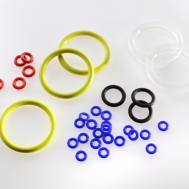Designing a rubber o-ring is no simple task: there are many important factors to consider that will impact the success of your application. Choosing the right material, ensuring compatibility and designing with the right size in mind are all key elements in avoiding seal failures.
To get a closer look at how to design the right o-ring for your application, here’s what you should always keep in mind:
Choose the Best Material
Every rubber material has unique characteristics that make it better suited for certain environments over others. For example, some rubber materials can handle high heat applications while others function best in the cold. Be sure to research the benefits and limitations of your o-ring material before you begin the design process.
Rubber o-rings are typically engineered out of a standard rubber material. However, certain application environments may require a customized material to handle all specifications. The six standard rubber materials that Apple Rubber always has on hand include:
- Nitrile
- Fluorocarbon
- Ethylene-Propylene
- Silicone
- Fluorosilicone
- Chloroprene
When choosing your rubber o-ring material, chemical compatibility is critical. If an o-ring is not compatible with chemicals and fluids that it is frequently exposed to, the application may result in costly o-ring failures. Be sure to choose the rubber material that can best handle the temperature, pressure, fluid and environmental conditions of your application.
You can learn more about the key features of standard rubber materials here.
Find the Right O-Ring Cross-Section
When designing your o-ring size, finding the right cross-section will help you determine all other dimensions and specifications. O-Rings are often available in standard sizes, aerospace standard AS568 and ISO 3601. Each of these standards can be designed with specific cross-sections and inside diameters that will ensure your o-ring is the right fit.
The size of your o-ring cross-section can create many benefits for performance and functionality. There are different advantages to o-rings with small cross-sections, as well as larger ones, including:
- Small cross-section o-ring: compact, lightweight, more cost effective for o-rings made with expensive elastomers, reduced machining of grooves
- Large cross-section o-rings: Less squeeze required to produce the seal which reduces compression set issues, greater tolerance variations in the machined groove
Work Closely with an Engineer
The best way to ensure your o-ring meets the exact requirements of your application is by working closely with an experienced engineer. At Apple Rubber, our Design Engineers are here to answer your questions, go over design features with you directly and even create custom prototypes of designs you wish to test out.
For more information about rubber o-rings and how Apple Rubber can help you through the design process, visit our o-ring product page or contact an engineer today.
Want to talk more about o-ring design?
Tweet us @AppleRubber to continue the conversation.
